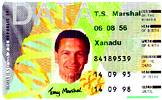

There is little doubt that the most basic reason for an identification card is simply to uniquely identify the cardholder. In Part 2 in the series of manufacturing secure ID cards, the discussion on first line security features continues.
* Opacity mark - The opacity mark, which is similar to a watermark, is a plastic that contains a unique translucent opacity mark available only from a few manufacturers. It is similar in principle and effect to a watermark found in paper documents and enjoys a high level of familiarity as a security feature.
* Embossed characters - Embossing is the impressing of raised characters to render a tactile pattern. The raised characters will also render the card uneven/not flat, thereby making the card more difficult to reprint. It is possible to develop unique embossing characters or logos that would not be included in commercially available embossers.

* Security code - It is possible for high-resolution colour printing systems to print a security code within the body of the colour printed photograph. For example, a security code can be printed in a nonproportional 2-point font that can imbed up to 20 characters on the edge or the bottom of the printed picture. The text can be printed on the image in colours that are complementary to the image or in black. This security code can be a repetition of the issued document number, an algorithm of the demographic data, or some other reference tying the document to the document holder.
* Screen traps or moiré patterns - Computer-generated designs can be incorporated that create variations in line frequency or modulation and reveal hidden images when copied or scanned (for example, 'void' or 'copy' will appear on photocopies, or 'original' will not appear on a copy). The sampling frequency of a colour copying machine or scanner is 'trapped' by the modified line pattern so that any attempt to copy the original will reveal the hidden image. These patterns are produced by using highly sophisticated design software (which, in some cases, is patented) that allows for varying either dot size or the spatial frequency of lines or dots. Applications of this technology are referred to as 'screen traps', 'screen angle modulation', 'sample band image coding', etc.
* Redundant data - Data can be displayed in more than one location on the ID, thereby raising the resistance to alteration. A simple visual inspection is required to determine if all data fields match. Redundant data can also be displayed in differing colours or fonts.
* Overlapping data - Variable data, such as a digitised signature or text, can be 'overlapped' with another field, such as a photo image. This technique makes it necessary to alter both fields if either one of them is changed, thereby increasing the tamper resistance of the card by making it more difficult to alter.
* 'Ghost' printing - Digital printing technology has made possible the printing of a 'ghost' image, a half tone reproduction of the original image, which is typically printed in the same area as the personal data. The second image appears as a light background to text data, significantly increasing the difficulty of altering the photo image or the data. Any attempt at photo substitution would require alteration of the printed data as well as the ghost image.
* Laser engraving - Laser engraving has been used in Europe for more than 10 years on high-security plastic cards for printing highly tamper-resistant variable data on a card. Using an intense laser beam, data is burned (or 'engraved') into the inner core of the card. The information cannot be mechanically or chemically removed without damaging the surface of the card, thereby providing an extremely effective tamper-resistant barrier. It is also possible to engrave data in such a way that the outer surface of the card is 'disturbed,' creating a tactile effect to printing. This security feature provides another level of verification similar to intaglio printing. However, it is extremely difficult to determine with the unaided eye if an image was laser engraved, particularly for an untrained inspector.
* Core inclusion - It is possible to manufacture a plastic document with several different layers of core stock. A coloured core material can be added to the card construction to create a coloured edge along the card. Although possible to counterfeit, the equipment required to construct this type of card, which represents significant investment, will deter most attempts at counterfeiting.
For more details contact Jannie van der Ventre, Mr ID on tel: (011) 907 6913, fax: (011) 907 3566.

© Technews Publishing (Pty) Ltd. | All Rights Reserved.